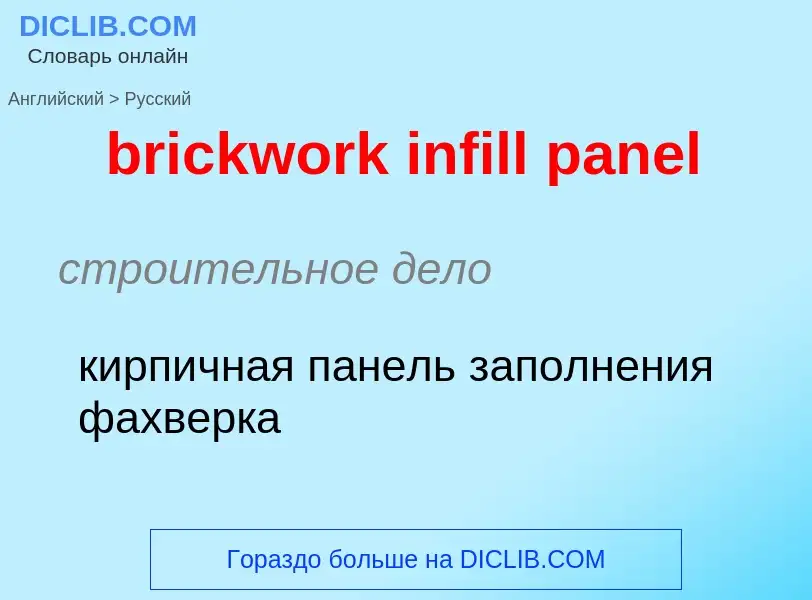Перевод и анализ слов искусственным интеллектом ChatGPT
На этой странице Вы можете получить подробный анализ слова или словосочетания, произведенный с помощью лучшей на сегодняшний день технологии искусственного интеллекта:
- как употребляется слово
- частота употребления
- используется оно чаще в устной или письменной речи
- варианты перевода слова
- примеры употребления (несколько фраз с переводом)
- этимология
brickwork infill panel - перевод на русский
строительное дело
кирпичная панель заполнения фахверка
общая лексика
заполнение
засыпка
строительное дело
заполнение (напр. фахверка, межбалочного пространства)
нефтегазовая промышленность
загущать (проектную сетку скважин)
Смотрите также
существительное
общая лексика
заполнение
глагол
общая лексика
заполнять
['pænlʃəu]
общая лексика
теледискуссия
телевикторина
телевизионная программа «Ответы на Ваши вопросы»
общая лексика
каркасная стена с заполнением
Определение
Википедия
.jpg?width=120)
In urban planning, infill, or in-fill, is the rededication of land in an urban environment, usually open-space, to new construction. Infill also applies, within an urban polity, to construction on any undeveloped land that is not on the urban margin. The slightly broader term "land recycling" is sometimes used instead. Infill has been promoted as an economical use of existing infrastructure and a remedy for urban sprawl. Its detractors view it as overloading urban services, including increased traffic congestion and pollution, and decreasing urban green-space. Many also detract it for social and historical reasons, partly due to its unproven effects and its similarity with gentrification.
In the urban planning and development industries, infill has been defined as the use of land within a built-up area for further construction, especially as part of a community redevelopment or growth management program or as part of smart growth.
It focuses on the reuse and repositioning of obsolete or underutilized buildings and sites. This type of development is essential to renew blighted neighborhoods and to knit them back together with more prosperous communities.
Urban infill Projects can also be considered as a means of sustainable land development close to a city's urban core.
Note that redevelopment or land recycling is a broad term that described development that occurs on previously developed land. Infill development differs in its specificity because it describes buildings that are constructed on vacant or underused property or between existing buildings. Terms describing types of redevelopment that don't involve using vacant land should not be confused with infill development. Infill development is commonly misunderstood to be gentrification, which is a different form of redevelopment.

.jpg?width=200)
![A recording of radio panel show ''[[Wait Wait... Don't Tell Me!]]'', featuring, from left, announcer and scorekeeper [[Carl Kasell]]; host [[Peter Sagal]]; and panelists [[Adam Felber]], [[Roxanne Roberts]] and [[Keegan-Michael Key]] before a live audience. A recording of radio panel show ''[[Wait Wait... Don't Tell Me!]]'', featuring, from left, announcer and scorekeeper [[Carl Kasell]]; host [[Peter Sagal]]; and panelists [[Adam Felber]], [[Roxanne Roberts]] and [[Keegan-Michael Key]] before a live audience.](https://commons.wikimedia.org/wiki/Special:FilePath/Wait Wait... Don't Tell Me! Live Taping.jpg?width=200)
 20.jpg?width=200)
![Kindle Keyboard]] e-reader displaying a page of an e-book. The Kindle's image of the book's text will remain onscreen even if the battery runs out, as it is a static screen technology. Without power, however, the user cannot change to a new page. Kindle Keyboard]] e-reader displaying a page of an e-book. The Kindle's image of the book's text will remain onscreen even if the battery runs out, as it is a static screen technology. Without power, however, the user cannot change to a new page.](https://commons.wikimedia.org/wiki/Special:FilePath/Amazon Kindle 3.JPG?width=200)

![A large LED display at the [[Taipei Arena]] displays commercials and [[movie trailer]]s. A large LED display at the [[Taipei Arena]] displays commercials and [[movie trailer]]s.](https://commons.wikimedia.org/wiki/Special:FilePath/Taipei Mini-Big Egg 02.jpg?width=200)

